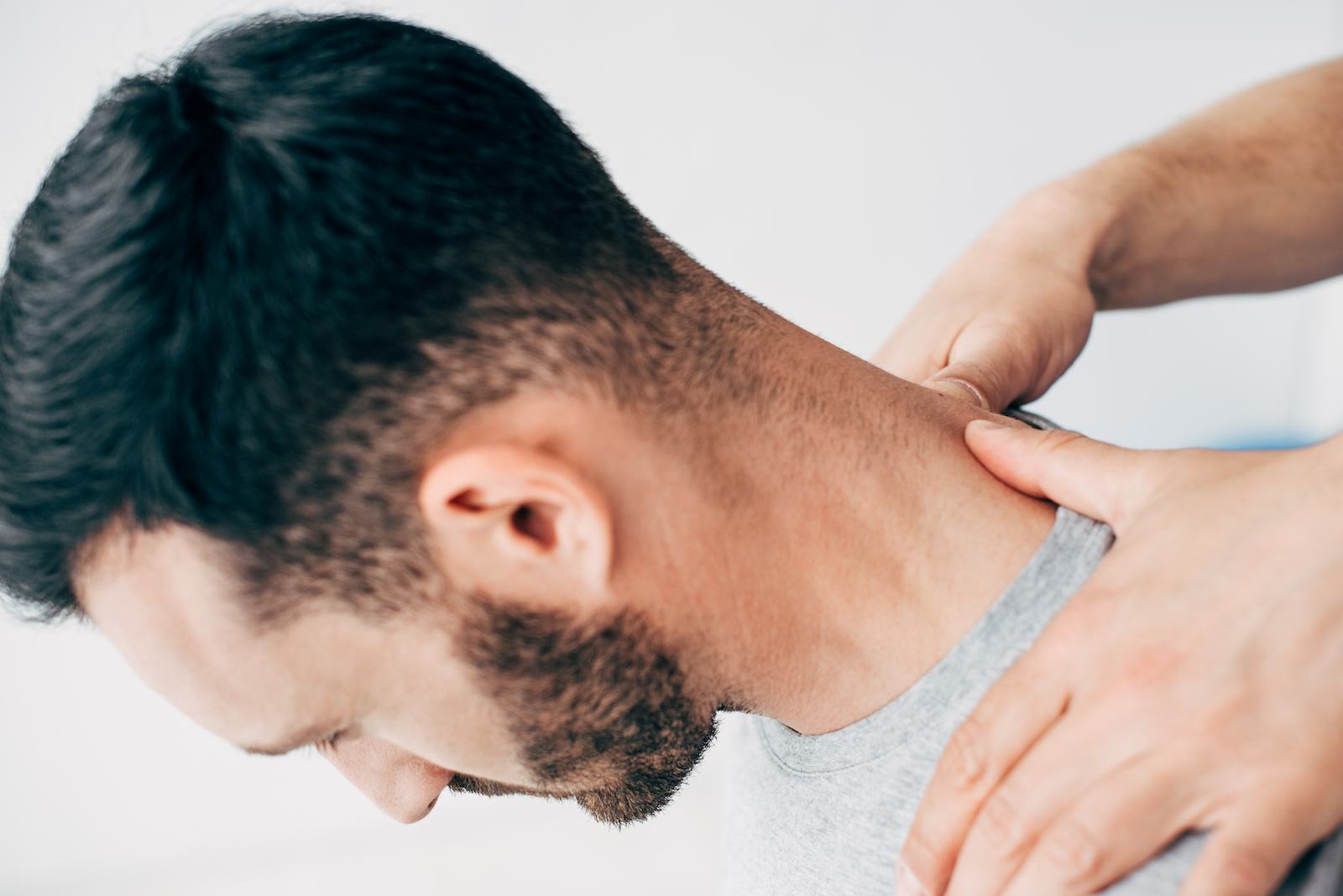Disc desiccation is the gradual loss of hydration (water) of an intervertebral disc in the spine, which leads to disc dehydration and disc degeneration. Disc desiccation is an inevitable part of aging, but some things can make disc desiccation worse. Dr. Todd Lanman is a world expert in diagnosing and treating disc desiccation. The following guide will help you learn more about this ubiquitous condition.
Understanding Disc Desiccation
What is Disc Desiccation?
Disc desiccation is to the gradual loss of hydration (water) of an intervertebral disc in the spine, which leads to disc heroization and disc degeneration.
Anatomy of Spinal Discs
Intervertebral discs are located between each vertebra in the spine, making up about 25% of the total spinal column height. Each disc has two main components, the annulus fibrosus and the nucleus pulposus. The annulus fibrosus is the tough, outer ring of fibrocartilage that surrounds the disc and the nucleus pulposus is the soft, gel-like center of the disc. The nucleus pulposus has a high water content, which helps distribute pressure evenly across the disc. The discs act as shock absorbers, allowing for flexibility and movement between the vertebrae. However, disc desiccation causes the nucleus pulposus to dry out.
Process of Disc Degeneration
Stages of Disc Degeneration:
1. Dysfunction Stage:
The discs begin to lose their ability to properly cushion and support the spine.
There may be mild discomfort, stiffness, and reduced range of motion.
This is often the earliest stage of degenerative disc disease.
2. Dehydration Stage:
The discs lose water content and become less effective at absorbing shocks.
This can lead to chronic back/neck pain and occasional numbness/tingling.
Conservative treatments like physical therapy become important.
3. Stabilization Stage:
The body tries to compensate by forming bone spurs and increasing bone density.
This can lead to spinal stenosis and more consistent, intense pain.
Physical therapy, bracing, and pain management become crucial.
4. Collapsing Stage:
The discs have deteriorated significantly, causing vertebrae to collapse.
Severe chronic pain and disability are common at this advanced stage.
Surgical interventions like disc replacement may be necessary
Natural Aging vs. Pathological Factors
Spinal discs dry out over time as we age. Some pathological factors that can accelerate the disc desiccation process include obesity and excess weight, physical inactivity and living a sedentary lifestyle, improper lifting techniques, and spinal injuries.
Symptoms of Disc Desiccation
The symptoms of disc desiccation vary depending on the location and severity of the disc desiccation. In mild cases, there may not be any noticeable symptoms, while in more severe cases, the disc degeneration can lead to nerve compression and radiating pain or weakness. Some patients have no pain even with severe disc degeneration and some have terrible pain. We are all different.
The key symptoms of disc desiccation are:
Stiffness in the neck or back
Pain, ranging from mild to severe
Weakness
Tingling or numbness
Loss of height
Radiating pain, tingling, or numbness in the arms or legs if the degenerated disc is compressing nearby nerves
Muscle weakness or atrophy in the back or extremities due to nerve compression or lack of physical activity
How is disc desiccation treated?
There are two common strategies for disc desiccation treatment: conservative or surgical treatment. Conservative treatment options include analgesics, physical therapy, and anti-inflammatories. Corticosteroid injections can be given to treat nerve (radicular) pain such as burning, stinging, shooting pain that runs down a limb. Surgical treatments, such as artificial disc replacement or spinal fusion are for people who fail to find adequate relief from conservative treatments.
Causes of Disc Desiccation
Age-related Degeneration
Age is the major risk factor for disc desiccation. Sadly, there is no cure for aging, but you can take steps you preserve the health of your spinal discs by getting healthy nutrition, plenty of hydration, and moderate exercise.
Lifestyle Factors
Jobs that put excessive pressures on the spine, such as heavy physical labor jobs, can increase the risk for disc desiccation. The same is true for sports that require the spine to twist (golfing) or compress (gymnastics, tackle football). On the other end of the spectrum, living a sedentary lifestyle can also accelerate disc desiccation. Obesity and smoking also increase the risk for disc desiccation.
Traumatic Injury
Contrary to widely held beliefs, traumatic injuries are rarely the cause of disc desiccation. That said, a traumatic injury can cause the disc to herniate or rupture under certain circumstances.
Treatment Options for Disc Desiccation
Conservative Approaches
Physical exercise is perhaps the best non-surgical approach to relieve pain from disc desiccation. Exercises that increase the strength of the paraspinal muscles (muscles along the spine) will pain and disability. Specifically, exercises with moderate to a high volume of low repetition and frequency.
Medications
Non-steroidal anti-inflammatory drugs (NSAIDs) and acetaminophen, opioids, and muscle relaxants are options to relieve pain. Each has advantages and disadvantages. Even though some of these can be without a prescription, it is important to discuss all medicines you are taking with your spine surgeon. Importantly, these medications do not alter the course of disc desiccation, they simply receive pain.
Minimally Invasive Procedures
Epidural steroid injections and steroid injections near the nerve root reduce inflammation and relieve pain. Unfortunately, the relief is usually temporary and the injections need to be repeated.
Surgical Interventions
Surgery is the only definitive treatment for disc desiccation. If the disc desiccation becomes so bad that it causes chronic, intractable pain, a spine surgeon may need to perform either artificial disc replacement or spinal fusion. In both cases, the desiccated disc is removed. In ADR, and artificial disc is placed between vertebra. In fusion, the bones are held together with metal instrumentation while an artificial bone matrix knits the bones together over time.
Final Thoughts from Dr. Lanman
Disc desiccation comes for all of us, but staying ahead of the process can mean the delaying or even preventing symptoms from occurring. Body weight control, moderate exercise, and good nutrition and hydration can slow the effect of disc aging. That said, if disc desiccations does become symptomatic it is important to speak with a disc desiccation expert to discuss you options. Dr. Lanman takes disc desiccation very seriously and has helped countless patients with this issue. If you are concerned about disc desiccation or are experiencing symptoms, contact Dr. Todd Lanman today for a consultation.
FAQS:
Is disc desiccation always accompanied by pain?
No, disc desiccation is not always accompanied by pain. Many people with disc desiccation may not experience any noticeable symptoms or pain. Symptoms of disc desiccation can include stiffness, weakness, tingling sensations, and pain that may radiate down the legs.
What are the success rates of surgical interventions for disc desiccation?
The success rate for microdiscectomy surgery is generally high, with large-scale studies showing good to excellent results for 76 to 100% of patients who undergo the procedure. In a study of 946 patients who underwent lumbar total disc replacement, satisfaction rates ranged from 75.5% to 93.3%. Cervical disc replacement success rates are 91.6 to 98.1%.
How long does it take to recover from surgery for disc desiccation?
Most people can return to their usual activities around 4 weeks after microdiscectomy surgery. Likewise, most people can return to their usual activities around 8 to 12 weeks after artificial disc replacement surgery. Lastly, recovery from a spinal fusion procedure can take up to 6 months.
Can disc desiccation recur after treatment?
Five to 19% of herniated discs can re-herniate at some point after a microdiscectomy procedure. Disc desiccation and herniating does not occur after artificial disc replacement or spinal fusion because the disc is removed during those procedures.







